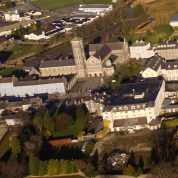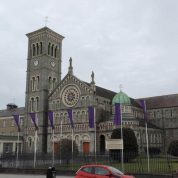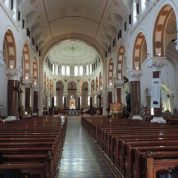Cathedral of the Assumption, Thurles
Parish
Parish Priest
Address
Cathedral Street, Thurles, Co. TipperaryContact
| Sunday | |||||
|---|---|---|---|---|---|
| 11:00 am | |||||
| Saturday | |||||
| 7.00pm | |||||
| Monday | |||||
| 11:00 am | |||||
| Tuesday | |||||
| 11:00 am | |||||
| Wednesday | |||||
| 11:00 am | |||||
| Thursday | |||||
| 11:00 am | |||||
| Friday | |||||
| 11:00 am | |||||
|
Pallottine College Chapel: 10:00 am daily including Sunday Funeral Masses: 11:00 am in both churches. If there is a Funeral Mass in Bothar na Naomh Church - the Cathedral 11:00 am Mass will be transferred to Bothar na Naomh Church - in other words, there will not be two 11:00 am Masses on the day of a funeral from Monday to Saturday. Sunday Funerals: Bothar na Naomh Church 9:30 am Cathedral 11:00 am Baptisms: Cathedral Every Saturday 5:30 pm. Bothar na Naomh: By arrangement with the Parish Office. For further details please see www.thurlesparish.ie |
|||||
Introduction
The Cathedral is the fourth church to be built on this site. The first one recorded was a Carmelite church built in the early fourteenth century. After the dissolution of the monasteries in the 1530’s it fell into disrepair. The second church, known as the Matthew Chapel was built around the mid eighteenth century under the partronage of George Matthew who lived in Thurles at the time. The third church built on the site was known as the ‘Big Chapel’ and was dedicated to Saint Patrick. This church was a spacious, T-shaped building built between 1807-1808 at a cost of £10,000. The big chapel served as the Cathedral until the early 1860’s.
The fourth Church built here is the present Cathedral. Work began on it in 1861. Dr. Patrick Leahy who was Archbishop at the time decided to replace the ‘Big Chapel’ with a more grandiose structure. He regarded the ‘Big Chapel’ as “not worthy of this great diocese much less to be the metropolitan church of Munster”. Dr. Leahy loved all things Roman: chant, Roman ceremonies and buildings. The Archbishop engaged the well-known and established church architect of the day, J.J. McCarthy, who abandoned his normal Gothic revival style to accommodate Dr. Leahy’s preference. So McCarthy used an Italianate Romanesque style. The Cathedral is modelled on the Cathedral of Pisa in Northern Italy. The foundation stone was laid in 1865 and by 1870 it was roofed and the work began on the interior. The consecration was performed by Dr. Leahy’s successor, Dr. Thomas Croke on 22nd June 1879. The total cost of construction of the Cathedral was £30,000. The bulk of the finance came from within the Diocese and the debt was cleared by its completion. Dr. Leahy was a skillful fundraiser. He levied each parish according to its ability to pay thus maximizing the return from the diocese. Dr. Leahy visited every Church in the Dioceses seeking support for the Cathedral and he also sent collectors abroad to Canada, America and England to tap the Irish in these countries.
Special Features
The most interesting and beautiful feature of the Cathedral is the high-domed and elaborate tabernacle. This was designed by Giacoma della Porta who was one of the architects of St. Peter’s Basilica in Rome and was a student of Michelangelo. This tabernacle was made for the Gesu Church in Rome. When the Gesu was being renovated in the mid-nineteenth century, Dr. Leahy purchased the tabernacle for Thurles. It is made from giallo antico, rosso antico, africano – beautiful antique marbles. The door is bronze with a silver host bearing the letters I.H.S. The two front pillars are Galway marble.
The tabernacle rested on the Altar until the renovations of the 1970s.
The Altar is of white marble inlaid with precious stones (malachite, lapis, lazuli, rosso agate, to mention a few) and a variety of other marbles. The white marble is supported by an arcading of sixteen columns – six of which are yellow Sienna marble, six griotte and four of vert campan – with their bases and capitals of bronze supporting the table of the altar which rests on solid masonry. On one side of the Cathedral, to the left as you look from the front gates, is the bell tower or campanile which is one hundred and fifty feet high and is Thurles’ most important landmark. The tower clock was presented to the people of Thurles by Dr. Croke on the occasion of his silver jubilee in 1895. Originally it had three faces but a fourth was added later. On the other side of the Cathedral is the free standing Baptistery which resembles that of Pisa and other European Cathedrals in being separate from the main building. It is built in the Byzantine style of limestone quarried locally. The dome of the baptistery was recoated with copper in 1927. The Baptismal Font in the Baptistery is unusual in that it was originally used as a fountain. Sea horses support the basin and it has four inter-twined serpents carved above its upper rim. A stained glass window in the baptistery appropriately depicts the Baptism of the Lord. The Rose Window in the façade of the building was designed and erected by Messrs. Mayer and Co. of Munich. The stained glass windows in the apse behind the sacristy portray figures from the Bible of Christ, of Our Lady and the saints.
New Baptismal Font & Aumbry
These are situated in the north transept of the Cathedral. They are the work of Mark Ryan, liturgical designer. They are made of cast bronze mounted on Portland stone. The new font was necessary to accommodate the large numbers attending christening ceremonies and its presence in the cathedral building is a constant reminder to all visitors of our faith journey.
The Aumbry contains the holy oils – Catechumens; Chrism; Infirmorum; that are used in the celebration of the sacraments of Baptism, Anointing of the Sick, Ordination and Confirmation.
Blessed Sacrament Chapel:
The former mortuary chapel and later the Croke chapel is the Blessed Sacrament Chapel since 1997. As part of the recent restoration project Mark Ryan was commissioned to design a new repository for the Exposition of the Blessed Sacrament. Linking with the Aumbry and new Baptismal Font we see his use of cast bronze mounted on Portland stone. His design is inspired by the story of the ‘Burning Bush’ in Exodus 3: 1- 6. From the middle of the bush Yahweh spoke to Moses and dcelared himself to be “the God of Abraham, Isaac and Jacob”. It was here that Moses accepted God’s call to free his people from slavery in Egypt.


